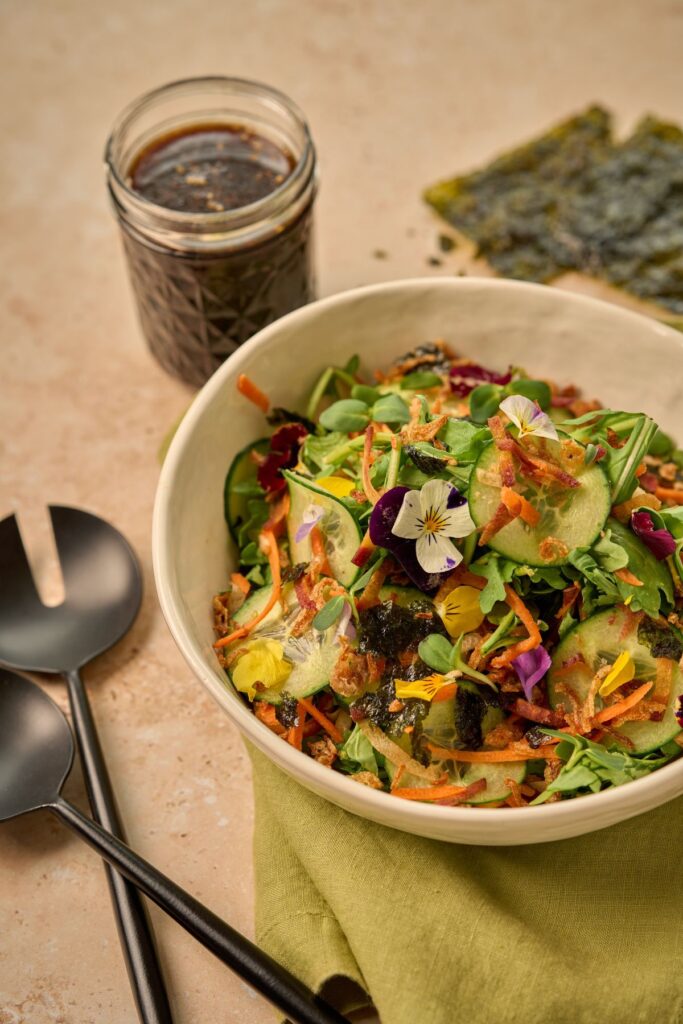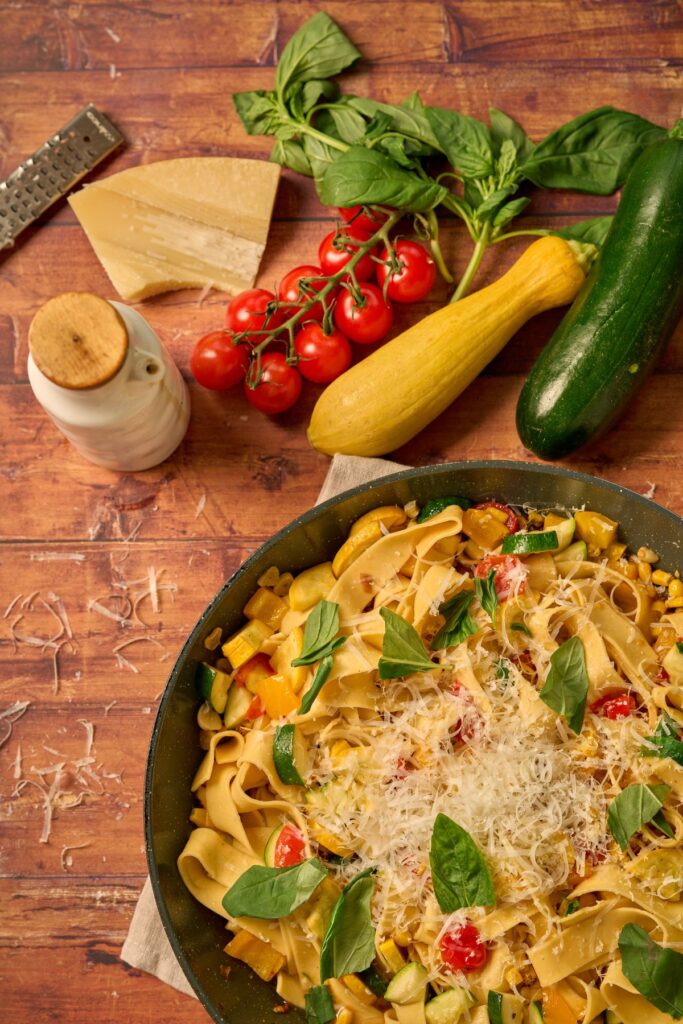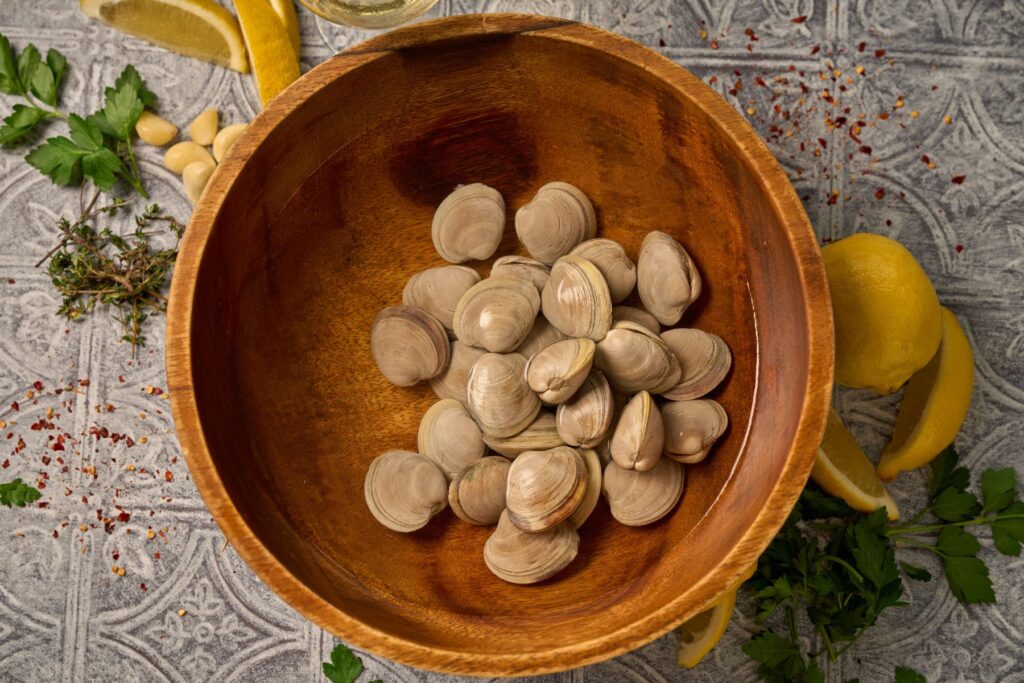
In Season: Eat Your Water
Recipes by Chef Rachel Ponce
Photography by Hugo Martinez
Water is not often thought of as an ingredient, but it’s essential — in one way or another — to all that we cook and eat. There is no food without water. Here, we explore its versatility by cooking with it in three distinct ways: as a main ingredient, as a means for cooking the dish and within foods that require it for survival.
Mizuna Salad with Water-Based Honey Garlic Dressing
Refreshing and filling, this salad is tossed in a water-based dressing, sprinkled with sesame seeds and topped with seaweed. Seaweed not only helps the ocean thrive, but adds high protein to a dish. Mizuna is a tender Japanese green with a peppery flavor. Mustard greens and arugula are great substitutes for the mizuna.
Serves 4
INGREDIENTS
- 4 cups mizuna, torn into bite-sized pieces
- 1 cup carrots, shredded
- ½ cucumber, thinly sliced
- ¼ cup toasted sesame seeds
- ¼ cup dried seaweed (such as wakame or nori), torn into small pieces
For water-based honey garlic dressing:
- ¼ cup water
- 2 tablespoons rice or apple cider vinegar
- 1 tablespoon soy sauce or tamari
- 1 teaspoon sesame oil
- 1 teaspoon honey
- 1 clove garlic, minced
- 1 teaspoon salt
PREPARATION
In a large bowl, combine mizuna, carrots and cucumber. Toss gently to mix. Whisk together all dressing ingredients in separate bowl. Drizzle dressing over salad mix and toss gently to coat evenly. Just before serving, sprinkle toasted sesame seeds and seaweed over top for added texture and flavor. Enjoy immediately for best texture.
Tip: This pairs beautifully with grilled proteins or can be enjoyed on its own as a light and nutritious dish.
Summer Fresh Pasta
Using seasonal fruits and vegetables helps conserve water by reducing the needs for irrigation and transporting materials long distances. Shopping by season also supports local farming practices that minimize water use compared to corporate farms. This dish is chock-full of delicious summertime produce. Delight in nature’s bounty!
Serves 4
INGREDIENTS
- 12 ounces fresh pasta (like fettuccine, tagliatelle or pappardelle)
- ¼ cup salt
For the sauce:
- 2 tablespoons olive oil
- 3 cloves garlic, minced
- 1 cup cherry tomatoes, halved
- 1 medium zucchini, diced
- 1 medium yellow squash, diced
- 1 cup fresh corn kernels (about 2 ears of corn)
- 1 bell pepper, diced
- 1 teaspoon salt
- 1 teaspoon ground black pepper
- 1 teaspoon red pepper flakes
- 1 cup fresh basil leaves, roughly torn
- Juice of 1 lemon
- ½ cup grated Parmesan cheese (or more to taste)
PREPARATION
Step 1
Bring large pot of salted water to a boil. Add fresh pasta and cook according to package instructions until al dente. Reserve about 1 cup of pasta water, then drain pasta and set aside.
Step 2
In a large skillet or pan, heat olive oil over medium heat. Add garlic and sauté for about 1 minute until fragrant, being careful not to burn it. Add to pan the cherry tomatoes, zucchini, yellow squash, corn and bell pepper. Sauté vegetables about 5−7 minutes, until beginning to soften. Season with salt, pepper and red pepper flakes.
Step 3
Add cooked pasta to skillet with vegetables. Toss to combine, adding a little reserved pasta water if needed to help distribute sauce. Toss in lemon juice and fresh basil. Stir to combine well. Remove from heat and sprinkle with grated Parmesan cheese, tossing gently. Serve immediately. Garnish with additional basil and Parmesan cheese, if desired.

Homemade Pasta
Making pasta from scratch may seem daunting but it’s actually a straightforward and rewarding experience. The soft dough transforms into a toothsome dish with the help of water that’s used to boil the noodles to just the right texture. Be brave and try it; you may never go back to store-bought pasta.
INGREDIENTS
- 2 cups all-purpose flour, plus extra for dusting
- 3 large eggs
- ½ teaspoon salt
- 1 tablespoon olive oil
PREPARATION
Step 1
On a clean surface or in large mixing bowl, make a mound with flour. Create a well in center of flour mound. Crack eggs into well. Add salt and olive oil. Using a fork gently beat eggs, gradually incorporating flour from edges of well. Continue until mixture becomes too stiff to mix with a fork. Use hands to bring dough together, kneading it on floured surface, for about 8−10 minutes until dough is smooth and elastic. If dough is sticky, add a little more flour as needed. Wrap dough in plastic wrap or cover with a damp cloth. Let rest at room temperature for at least 30 minutes (this allows the gluten to relax, making it easier to roll out).
Step 2
After resting, divide dough into 4 pieces. Dough that’s not being worked should remain covered to prevent drying out. Use rolling pin or a pasta machine to roll out 1 piece of dough to desired thickness (generally about ⅟16 inch for thin pasta). Dust with flour as needed to prevent sticking. Once rolled out, cut pasta into desired shape*.
Step 3
Bring large pot of salted water to a boil. Add fresh pasta and cook for 2−4 minutes, depending on thickness. Fresh pasta cooks much faster than dried pasta, so watch closely. Taste a strand to check for doneness. When al dente, drain and serve with preferred sauce.
*Pasta shapes
Fettuccine Roll sheet loosely and slice into long, flat strips.
Tagliatelle Cut into wider strips, about ¼-inch wide.
Lasagna Cut into rectangles.
Pappardelle Cut into broad noodles, about ¾−1-inch wide.
Tips
Storage For later use, dry pasta by hanging on a pasta drying rack, or storing in an airtight container in refrigerator for up to 2 days. For longer storage, freeze it.
Flavor Variations Add herbs, spinach or beet purée to dough for flavor and color.
Serves 4
INGREDIENTS
- 2 pounds steamer clams, rinsed and scrubbed
- 2 tablespoons olive oil
- 4−5 cloves garlic, minced
- ½ cup dry white wine
- 1 teaspoon red pepper flakes
- 1 tablespoon fresh thyme
- 1 teaspoon salt
- Pinch of ground black pepper
- ¼ cup chopped fresh parsley, plus extra for garnish
- 1 lemon, cut into wedges, for serving
- Crusty bread, for serving
PREPARATION
Step 1
Soak clams in bowl of cold water for about 20−30 minutes, helping them expel any sand or grit. Rinse thoroughly under cold water afterward.
Step 2
Cook clams: In large pot or Dutch oven, heat olive oil over medium heat. Add minced garlic and sauté for about 1 minute until fragrant but not browned. Add white wine, red pepper flakes, thyme and a pinch each of salt and pepper. Bring mixture to a simmer. Add cleaned clams to pot, cover and steam for about 5−7 minutes. The clams are done when they have opened up; discard any that remain closed. Once clams are cooked, stir in chopped parsley and remaining salt, tossing gently to mix.
Step 3
Using slotted spoon, transfer clams to a large serving bowl, pouring some broth over the top. Serve with lemon wedges and crusty bread for soaking up the delicious broth.
Enjoy these briny steamer clams with a chilled glass of wine, as a perfect summer treat.




